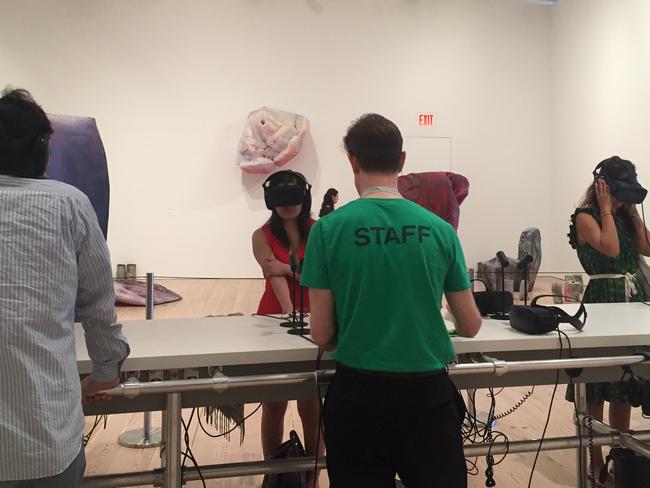Sickest artwork of all time allows viewers to watch man beaten to death
A GRUESOME virtual reality installation named ‘Real Violence’ allows viewers to watch a man being beaten to a bloody mess.
A GRUESOME installation labelled “one of the most viscerally disturbing” artworks of all time is traumatising New York gallery visitors.
The shocking exhibit, “Real Violence” by Jordan Wolfson, invites people to “witness the artist himself engaged in an act of unexplained violence” through a virtual reality headset.
Visiting the city last week, I came across the installation at modern art gallery the Whitney, and decided — with trepidation — to take a look.
Viewers are told little about the content in advance, with the description on the wall noting that the assault is “presented with no motive or backstory” ensuring it is a “distillation of pure intensity”. We are warned by staff overseeing the installation that the footage is extremely violent and unsuitable for under-17s. They tell us to put on a virtual reality headset, hold on to a metal rail and not let go.
I can report that the Jordan Wolfson VR piece in the Whitney Biennial is the most disturbing, horrifying artwork I have ever seen.
— Andrew Russeth (@AndrewRusseth) March 13, 2017
Can you get PTSD from an artwork? Because I think Jordan Wolfson gave it to me at @whitneymuseum biennial
— Emily Colucci (@emilycolucci) March 13, 2017
Only made it through 30 seconds of Jordan Wolfson's "Real Violence" @ Whitney Biennial
— Daniel Kingery (@DanielKingery) May 3, 2017
The scene is an ordinary Manhattan street. Cars drive past, pedestrians wait to cross the road. We hear a Hebrew chant. A man kneels on the pavement as Wolfson approaches, picks up a baseball bat, and begins viciously beating and later stamping on him.
At first, I watch in horror, asking myself whether this is real, and whether someone had agreed to be violently attacked for the sake of art. After all, the Jackass stars were regularly assaulted and injured in the name of entertainment.
But as the victim collapses in a heap and his face becomes increasingly bloodied and mangled, I realise this cannot be real, because he would be dead. Later, I learn this is an animatronic dummy with a face added later using CGI, but it looks agonisingly realistic — we are essentially watching a simulation of a murder, and it is excruciating.
The viewer is told they can look around, so I occasionally glance at the traffic passing in the road, and the indifferent crowds crossing the street behind me. But looking away feels brutally callous, like walking past someone dying in the road.
“The victim makes eye contact with us intermittently, possibly implicating us in the scenario,” read the wall plaque, casting us as titillated voyeurs. “Wolfson is interested in violence as a rupture or distortion of our everyday consciousness.”
The Jordan Wolfson VR piece that's up at the Whitney Biennial is one of the single most disturbing works of art I've ever seen.
— Josh Gallagher (@JAGthoughts) March 18, 2017
Wolfson's Whitney video is deeply offensive. Why have a white man beat another to death while chanting a blessing in Hebrew? To inflame?
— Susan L. Halper (@Suhalper) March 24, 2017
so i saw that jordan wolfson vr piece at the whitney today and i must say...it's not as good and "traumatizing" as yall said it was 0/10
— t® (@terrellllllll) May 23, 2017
Afterwards, I ask a staff member if he can tell me any more about the artwork. “It’s not our role to interpret,” he says.
But he is happy to talk about the responses he has seen. “We get all kinds of reactions. Some people are into virtual reality and interested in the technical side. Some people shout, some take the headset off almost immediately, some laugh. Hopefully it’s nervous laughter.”
Still shaken, I turn to look at the people around me. An older woman asks a girl leaving how it was. “Well, it’s violence, yeah...” says the girl, unhelpfully.
Others look around curiously. A boy giggles. Like a disapproving 30-something cliche, I start to wonder if younger millennials are deeply desensitised to violence thanks to television, movies, computer games and the internet.
The artwork has caused a sensation since it opened as part of the Whitney Biennial in March. One critic called the installation “the most disturbing, horrifying artwork I have ever seen”.
Others called it “repellent”, “a pantomime snuff movie” and “a gleeful embodiment of white, male anger.” A visitor wrote on Twitter that he was “high key f***ed up” from the work and still thinking about it five hours later. Three weeks after my viewing, I can relate.


Of course, that is the intention. Wolfson is exploring a spike in anti-Semitic violence since the election of President Trump; he is asking how someone can be killed on the street with no consequences; and he is defying taboos to expose how violence is a daily occurrence for some people, while the rest of us don’t want to look.
Nevertheless, many believe he has gone too far, and that his efforts to provoke a reaction amount to a cheap, tacky gimmick.
The biennial featured another controversial work — Dana Schutz’s “Open Casket”, based on a photograph of Emmett Till, a 14-year-old African-American abducted, tortured and murdered by white Mississippi racists in 1955. The engagement with such emotive subject matter by a middle-class white artist caused ripples of anger in the wake of the Black Lives Matter movement.
But Wolfson’s work is arguably more unsettling, with the artist insisting he is trying to cut off political and contextual context so the viewer can experience “pure violence”.
The sickening installation has cemented Wolfson’s reputation. But is this art, or just for shock value?




